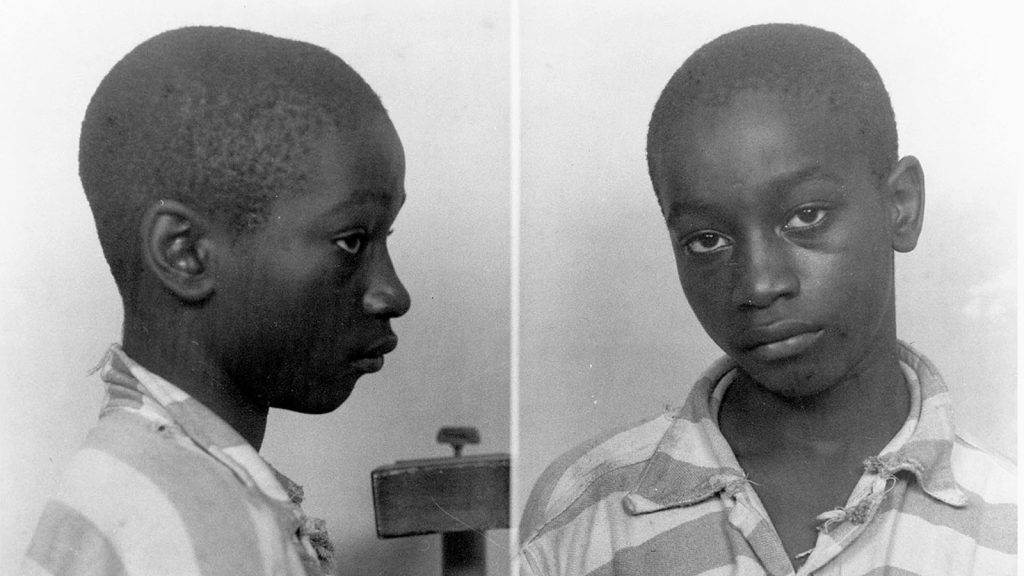
June 16, 1944 was execution day at the Central Correctional Institution in Columbia, and next on the docket to confront the electrical chair was George Stinney, a 14-year-old African American boy from Acolu, South Carolina. George weighed merely 95 pounds and stood at only 5” 1′ at the time he was strapped to an electric chair too big for his physique.1 Due to George’s small physique, extra holes needed to be punched into the chair’s leather bindings before the bindings could fit onto George’s limbs. This extra step bought George a couple extra minutes of life before he faced the electric chair.2 What was 14-year-old George Stinney thinking about right before execution? Surely not that he would soon become the youngest person executed in the 20th century.3

On March 24, 1944, tragedy and injustice came strolling into the small segregated lumber mill town of Alcolu, South Carolina. Betty June Binnicker, 11, and Mary Emma Thames, 7, were walking with their bike when they came across Aime Stinney Ruffner and George Stinney. The girls asked Aime and George whether or not they knew where they could find Maypops. Aime and George responded with a “no” and the girls went on their way. The night of March 24, Betty and Mary were reported missing after both girls failed to return home. The morning after, Betty June Binnicker and Mary Emma Thames were found dead in a ditch with their bikes laying on top of them. Police arrived at the Stinney household and arrested George, a 14-year-old African American boy, for the murders on Betty June Binnicker and Mary Emma Thames.4 Unfortunately, at the time police arrested George, the 1966 Supreme Court ruling on Miranda v. Arizona, which requires law enforcement officials to advise suspects of their rights, had not been ruled yet.5 After the police arrested and interrogated George without any access to his parents nor to an attorney, George confessed to the murders of Betty Binnicker and Mary Thame.6 George Stinney was not the only party impacted as a result of the murders, the Stinney family was persecuted by the rest of the town due the accusation against George. George Stinney Sr. was fired from work and the entire family was forced to permanently leave Acolu and move to Pinewood where the grandmother resided. Aime Stinney Ruffner stated, “We had no choice, the crowd came and they said they were going to get us.”7
The judge presiding over the case appointed Charles Plowden, 31-year-old local lawyer and aspiring politician, to represent George Stinney during the trial. On April 24, 1944, residents of Alcolu packed the local courthouse hoping justice would be served swiftly. A jury composed of 12 white men would be destined to determine George Stinney’s fate.8 Plowden failed to motion for a change of venue, which is a motion to change the location of a trial to overcome local prejudice. Stinney could have had a less partial jury in a different location. The prosecution’s case relied on the testimony of two police officers giving an account of Stinney’s confession he made during his interrogation. According to the police, Stinney confessed to having followed Betty Binnicker and Mary Thames after initially making contact with the girls, then unsuccessfully attempted to rape Betty, and then proceeded to beat both Betty and Mary with a railroad spike that had been laying around. The prosecution presented Stinney’s birth certificate as the last piece of evidence. The prosecution presented the birth certificate to make the case that Stinney was born on October 21, 1921, making him 14 years of age, which was traditionally the accepted age of criminal responsibility at the time.9 Plowden failed to cross-examine the prosecution’s witnesses, call forth any witness that could have corroborated with Stinney’s alibi, question the circumstances under which the police obtained the confession, nor to point out the lack of physical evidence, nor to point out the impracticality of a 14-year-old boy weighing 95 pounds and standing at 5 feet and 1 inch of physically being able to murder two girls, and finally failed to file an appeal. Plowden’s only defense comprised of the defendant being too young to be held responsible for the crimes he committed. Stinney’s trial, that would determine whether he lived or died, lasted a total of 3 hours. The judge sentenced the jury to deliberation, and 10 minutes later the jury comprised of 12 white men, found 14 year old George Stinney guilty of the murders of Betty June Binnicker and Mary Emma Thames. The judge sentenced George Stinney to death by electrocution. On June 16, 1944, the 2,400 volts of electricity passing through George Stinney rendered his body lifeless.10

70 years after the execution of George Stinney, Stinney’s three remaining siblings are seeking justice of their own with the help of a group of lawyers and civil rights advocates determined to exonerate Stinney. Stinney’s prosecution combined unconstitutional errors with serious misconduct. The team of attorneys argued in the Sumter County Courthouse that Stinney’s verdict was solely based on a coerced confession, therefore, the verdict should be thrown out.11 Due to new testimony, Stinney’s family, along with the team of attorneys, are hoping Judge Carmen T. Mullen, of the Fourteenth Circuit Court in South Carolina, rules in their favor. Despite most of the evidence, including Stinney’s confession and the transcript of the trial disappeared, Mullen heard new testimony from Stinney’s brothers and sisters, a witness from the search party, a child forensic psychiatrist, and a statement from Wilford Hunter, Stinney’s former cellmate.12 Frankie Bailey Dyches, the niece of one of the victims, stated, “He (George Stinney) was tried, found guilty by the laws of 1944, which are completely different now—it can’t be compared— and I think that it needs to be left as is.”13 Circuit Judge Carmen Mullen makes an important distinction in the Stinney case by stating that her task is not deciding whether Stinney is guilty or innocent, but rather to decide whether or not Stinney received a fair trial. On December 10, 2014, Circuit Judge Carmen Mullen vacated George Stinney’s conviction. Mullen ruled that Stinney’s confession was likely coerced and therefore inadmissible, “due to the power differential between his position as a 14-year-old black male apprehended and questioned by white, uniformed law enforcement in a small, segregated mill town in South Carolina.”14
George Stinney was tried, convicted of murdering two young White girls, and sentenced to death by electrocution, all in a single afternoon. The story of George Stinney showcases the irreversible actions that occur in a flawed criminal justice system that implements the death penalty primarily against minorities. The court system failed to provide George Stinney with a fair and impartial trial in 1944. As a result, George Stinney paid the ultimate price, death. 70 years after the death of Stinney, the Fourteenth Circuit Court in South Carolina ruled justly by vacating Stinney’s conviction. That moment on June 16, 1944 when 2,400 volts of electricity passed through Stinney’s body, it rendered him lifeless. The death of George Stinney sealed his fate in history as the youngest person executed in the 20th century. The finality of the death penalty by definition continues to risk the loss of innocents’ lives.
Warning: the video linked below is a very realistic, violent, and disturbing set of images of what the suffering and execution must have felt to young George Stinney Jr.
- Elaine Aradillas, Jill Smolowe, Howard Breuer, Michelle Boudin, “A Family’s Quest for Justice Wrongfully Executed,”(People, March, 2014), 73. ↵
- Charles Kelly, “Next Stop, Eternity,” (Life Rich Publishing, April 27, 2016), …. ↵
- Jesse Wegman, “A Boy’s Execution, 70 Years Later,” (New York: New York Times, June, 2014), 8. ↵
- Elaine Aradillas, Jill Smolowe, Howard Breuer, Michelle Boudin, “A Family’s Quest for Justice Wrongfully Executed,”(People, March, 2014), 75. ↵
- Miranda v. Arizona, 384 US 436 (1966). ↵
- Elaine Aradillas, Jill Smolowe, Howard Breuer, Michelle Boudin, “A Family’s Quest for Justice Wrongfully Executed,”(People, March, 2014), 75. ↵
- Elaine Aradillas, Jill Smolowe, Howard Breuer, Michelle Boudin, “A Family’s Quest for Justice Wrongfully Executed,”(People, March, 2014), 74. ↵
- Mark Kantrowitz, “The Killing of George Stinney Jr.,”(Rhode Island: Rhode Island Lawyers Weekly, 2018). ↵
- David Bruck, “Executing Teen Killers Again,” (The Washington Post, September 15, 1985). ↵
- Mark Kantrowitz, “The Killing of George Stinney Jr.,”(Rhode Island: Rhode Island Lawyers Weekly, 2018). ↵
- Jesse Wegman, “George Stinney was Executed at 14,” (New York: New York Times, January 12, 2015), 9. ↵
- Lindsey Beaver, “It took 10 minutes to convict 14-year-old George Stinney Jr. It took 70 years after his execution to exonerate him,” (The Washington Post, December 18, 2014). ↵
- Jesse Wegman, “George Stinney was Executed at 14,” (New York: New York Times, January 12, 2015), 8. ↵
- Brad Knickerbocker, “Executed at Age 14, George Stinney Exonerated 70 Years Later,”(Christian Science Monitor, December, 2014). ↵



97 comments
Mariah Garcia
This article was so well written that it has elicited a visceral reaction out of me. It is so frustrating to know that this young boy, not even a man, had his life stripped away due to circumstance of his situation. His lawyer’s incompetence, the judge and jury’s implied prejudice, and the society he grew up in added up to a perfect storm of bigotry that unfortunately swallowed George Stinney.
Danniella Villarreal
This article is extremely sad. To know that they sentenced a 14-year-old boy to death is completely wrong. The government back then was terrible and didn’t even care about the details of the case. The sentence to kill a young boy did no justice to anyone and did more harm than good. This young man was not even physically able to do what he said he had done. But of course, due to his race, it was easy to sentence him to death without having people question anything.
Fatima Navarro
I feel upset and very saddened by this article. How many cases such as these happened back in the day? Especially because of the racism that existed during that time period. He was a 14-yr old, black, and a team of only white men were in charge of sentencing him, how fair is that? Of course he wasn’t going to be found innocent even if he had been…
Isaiah Torres
I remember hearing about this before back in high school, but I never read the full article on how, and why they sentenced him to death at such a young age. It is sad to hear that somebody was sentenced to death without getting a fair trial. It wasn’t a good case, it was careless, and a 14 year old boy was said to be responsible for the killings of two little girls, when he clearly wasn’t capable physically. I hope the justice system now days doesn’t make another tragic mistake like this again, especially when it comes to a young kid who may be innocent all along. I liked this article because it pointed out all of the flaws of the case; and also explained the outcome even with the lack of evidence.
Thomas Fraire
This article is truly sad, I think a lot it tragic when anyone dies. But a 14-year-old boy who got charged for killing two girls and got sentenced to death, on a pretty sloppy case is even more tragic. I’m not sure the sentence brought peace to anyone if anything it probably devastated another family. I feel like putting the kid in jail might have been better. But, I also feel like the kid should’ve received a more fair trial, but at the end of the end of the day, our justice system isn’t always the justest.
Maya Mani
Even if the boy did murder these two girls, the trial itself was not fair. To rely merely on a confession from the boy, and then sentence him to death, is cruel, unreasonable, and inhumane. It’s such a sad story and while it’s good that the laws are different now, it doesn’t change what happened to him. There should have been much more evidence and time to resolve the case.
Andres Cano
Honestly, it blows my mind that this option of punishment was so viable at one point. I know that now we are taking stances to reduce the usage of the death penalty, but this is just sick. Fourteen years old and convicted of a rape and murder. It sounds to me as if the death penalty was just a way to keep the crowd happy. The people, especially the families of the victims needed someone to blame for such strange and spontaneous deaths, so who was with them that day? Well a colored kid was seen with them riding bikes prior to. It all just seemed so easy.
Makenzie Santana
It’s crazy to think that this was the kind of justice system we had about 75 years ago. The poor boy, a child, was hardly given a fair trial and was put to execution so cruelly. The assumption of him and the treatment he got just because of the color of his skin is just appalling. So quickly to find someone so young capable of the murder of two girls is unbelievable yet it’s what happened.
Amariz Puerta
Reading this article was so unreal for me composing of many different factors. Knowing that a fourteen-year-old boy could be capable of such thing seems nearly impossible. Also knowing that the courts were composed of white men, and probably did not give him the right to justice he deserved is devastating knowing that prejudicey is still a factor in his trial case. Our criminal justice system is so flawed due to the color of skin. It was sad reading about this but only gives me hope to diversify our justice system.
Cameron Lopez
I personally don’t believe that this 14 year old boy could take the lives of two girls. Then what puts me in more disbelief is the fact that they gave him s trial and then proceeded to execute him all in a single day. As a boy who supposedly took the lives of two girls, even if he did they should of definitely taken more time on this trial and deciding his fate. Especially the fact that he was a 14 year old boy. To me it seems like it was so quick with everything that happened I’m more than sure he was scared out of his mind and then on the same day he was given trial, they took his young life. So now the only question left is if this young boy didn’t commit this crime and his young life was taken. Who in all of this actually committed this crime and killed the 2 girls?